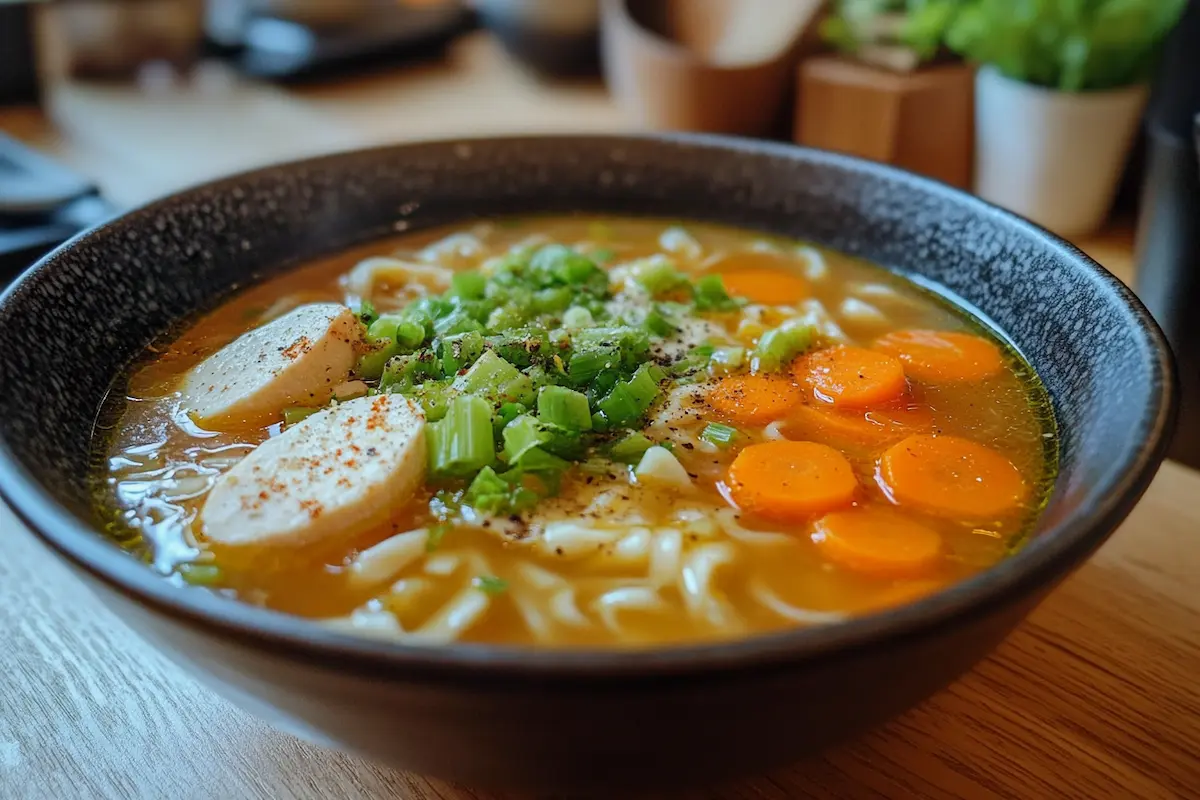Introduction
When the weather turns chilly or you’re craving a bowl of hearty comfort food, there’s nothing quite like ginger chicken noodle soup with carrots and celery. This beloved dish combines the warmth of chicken broth, the zing of ginger, and the wholesome goodness of fresh vegetables like carrots and celery. Whether you’re fighting off a cold, preparing a family meal, or looking for a soul-soothing recipe, this soup checks all the boxes. It’s easy to make, packed with nutrients, and tastes like a warm hug in a bowl. Let’s dive into the process of crafting this delightful soup.
1. Ginger Chicken Noodle Soup with Carrots and Celery: A Comforting Classic
1.1 The Origins of Chicken Noodle Soup
Chicken noodle soup has long been considered a universal comfort food. From ancient Chinese recipes to modern takes across Europe and America, this humble dish has nourished people for centuries. Its soothing properties make it a go-to remedy for colds and flu, not to mention its rich, savory taste is simply irresistible.
1.2 The Role of Ginger in Culinary Traditions
1.2.1 Ginger’s Health Benefits
Ginger isn’t just a spice; it’s a medicinal powerhouse. It’s been used in traditional medicine to combat nausea, improve digestion, and reduce inflammation. In soups, its bold, zesty flavor complements the mildness of chicken broth beautifully.
1.2.2 Why Ginger is Perfect for Soups
Adding fresh ginger to soup not only enhances the flavor but also imparts a soothing quality that’s perfect for warming up on cold days. The subtle heat of ginger pairs wonderfully with the comforting base of chicken broth.
1.3 Nutritional Benefits of Carrots and Celery in Soups
1.3.1 Carrots: The Sweet Touch
Carrots aren’t just for sweetness—they’re loaded with beta-carotene, which supports eye health and boosts immunity. Their bright orange color also brings a visual appeal to the soup, making it as pretty as it is delicious.
1.3.2 Celery: The Unsung Hero
Celery’s crisp texture and mild flavor balance out the sweetness of carrots. It’s rich in antioxidants and fiber, aiding digestion and reducing inflammation. In this soup, celery adds both crunch and health benefits.
2. Ingredients and Their Significance
2.1 Essential Ingredients for Ginger Chicken Noodle Soup
To make the perfect ginger chicken noodle soup with carrots and celery, choosing the right ingredients is crucial. Each component contributes to the soup’s flavor, texture, and nutritional value, turning a simple dish into a masterpiece.
2.1.1 Selecting the Right Chicken Cuts
When it comes to chicken noodle soup, using bone-in, skin-on chicken pieces is ideal. The bones add depth to the broth, while the meat stays tender and juicy. If you prefer a lighter version, boneless chicken breasts or thighs work too, though they may lack the richness of bone-in cuts.
2.1.2 The Importance of Fresh Ginger
Fresh ginger is a must for this recipe. Its sharp, spicy flavor enhances the broth, creating a warming and aromatic base. Powdered ginger doesn’t offer the same intensity, so stick with fresh for the best results.
2.1.3 Choosing Fresh Carrots and Celery
Opt for fresh, firm carrots and crisp celery stalks for this soup. Avoid limp or overly soft vegetables, as their flavors won’t be as vibrant. Organic options are great if available, but the key is freshness to ensure the soup tastes bright and full of life.
2.1.4 Optimal Noodle Varieties for Soup
Not all noodles are created equal when it comes to chicken noodle soup. Egg noodles are a classic choice, as they hold up well in the broth without becoming mushy. For a gluten-free option, rice noodles or zucchini noodles (zoodles) work beautifully.
2.1.5 Additional Aromatics and Seasonings
The right aromatics and seasonings can elevate your soup from good to unforgettable. Garlic, onion, and bay leaves add depth to the broth, while salt, pepper, and a pinch of turmeric enhance the overall flavor. Don’t forget to finish with fresh parsley or cilantro for a pop of freshness.
3. Step-by-Step Preparation Guide
3.1 Preparing the Ingredients
Before you start cooking, it’s essential to prep your ingredients properly. This ensures a smooth cooking process and a well-balanced soup.
3.1.1 Cleaning and Chopping Vegetables
Begin by thoroughly washing your carrots and celery. Peel the carrots and slice them into even, bite-sized rounds. For the celery, remove any stringy parts and chop into small pieces. Consistent sizes ensure even cooking and a better texture in the soup.
3.1.2 Marinating the Chicken
If you’re using raw chicken, marinate it lightly with salt, a dash of pepper, and a teaspoon of freshly grated ginger. Let it sit for 15–20 minutes to infuse the meat with flavor. This step enhances the taste of the chicken and complements the soup’s gingery undertones.
3.2 Cooking the Soup
Now comes the exciting part—bringing all the ingredients together to create a warm and hearty bowl of soup.
3.2.1 Sautéing Aromatics
Heat a tablespoon of oil in a large pot over medium heat. Add finely chopped onions, minced garlic, and freshly grated ginger. Sauté until fragrant and the onions are translucent, about 2–3 minutes. This step builds the foundation of the soup’s rich flavor.
3.2.2 Simmering the Broth
Pour in the chicken stock and add your marinated chicken pieces. Toss in a couple of bay leaves for an earthy aroma. Let the broth simmer gently for about 20–25 minutes, skimming off any impurities that rise to the surface. This creates a clear and flavorful base.
3.2.3 Adding Noodles and Final Touches
Once the chicken is cooked through, remove it from the pot and shred it using two forks. Return the shredded chicken to the pot along with the chopped carrots and celery. Add your noodles and cook until tender, usually about 5–7 minutes. Taste and adjust seasoning as needed before serving.
4. Serving Suggestions and Variations
4.1 Serving the Soup
Once your ginger chicken noodle soup with carrots and celery is ready, it’s time to serve it up in a way that makes everyone’s mouth water.
4.1.1 Ideal Accompaniments
Pair your soup with crusty bread, buttery crackers, or a side of garlic toast to add a delightful crunch. If you prefer a lighter option, a simple green salad works beautifully to complement the rich flavors of the soup.
4.1.2 Garnishing Ideas
For a finishing touch, sprinkle chopped fresh parsley or cilantro on top of each bowl. A dash of freshly ground black pepper or a squeeze of lemon juice can also brighten the flavors. If you enjoy a little heat, add a pinch of red chili flakes or sliced green chilies.
4.2 Variations of Ginger Chicken Noodle Soup
This soup is endlessly versatile, allowing you to tailor it to your preferences or dietary needs.
4.2.1 Vegetarian and Vegan Alternatives
Replace the chicken with tofu, tempeh, or chickpeas for a plant-based version. Use vegetable broth instead of chicken stock, and swap egg noodles for gluten-free or rice noodles to make it vegan-friendly.
4.2.2 Gluten-Free Noodle Options
For those avoiding gluten, rice noodles or spiralized vegetables like zucchini (zoodles) or sweet potato noodles are excellent substitutes. These options add a unique twist while keeping the soup hearty and satisfying.
4.2.3 Incorporating Additional Vegetables
Feel free to experiment with other vegetables. Mushrooms, spinach, bell peppers, or green beans can add extra layers of flavor and nutrition. Toss them in during the last few minutes of cooking to preserve their texture and color.
5. Health Benefits and Nutritional Information
5.1 Health Benefits of Ginger Chicken Noodle Soup
This soup isn’t just tasty—it’s packed with health benefits that make it a great choice for wellness and nourishment.
5.1.1 Immune-Boosting Properties of Ginger
Ginger is renowned for its immune-boosting properties. It contains compounds like gingerol, which can help combat inflammation, soothe sore throats, and fend off colds and flu. Adding ginger to your soup makes it a natural remedy for seasonal ailments.
5.1.2 Vitamins and Minerals in Carrots and Celery
Carrots and celery are nutritional powerhouses. Carrots are rich in beta-carotene, which supports eye health and boosts immunity, while celery offers antioxidants and fiber that aid digestion and reduce inflammation. Together, they bring a host of vitamins and minerals to your soup.
5.1.3 Protein Content from Chicken
Chicken is an excellent source of lean protein, which is essential for muscle repair, energy, and overall health. Including chicken in the soup makes it a filling meal while keeping the calorie count in check.
5.2 Nutritional Breakdown
Understanding the nutritional content of your soup helps you appreciate its balance of health benefits and flavors.
5.2.1 Caloric Content per Serving
A typical serving of ginger chicken noodle soup with carrots and celery contains around 250–300 calories, depending on the exact ingredients used. This makes it a light yet satisfying meal.
5.2.2 Macronutrient Distribution
This soup offers a balanced mix of macronutrients. It’s low in fat (especially if you skim the broth), moderate in carbs (thanks to the noodles), and high in protein, making it a wholesome choice for any meal.
6. Frequently Asked Questions (FAQs)
6.1 FAQs about Ginger Chicken Noodle Soup with Carrots and Celery
This section addresses some common questions to help you perfect your soup and make the most of this comforting dish.
6.1.1 Can I Use Pre-Cooked Chicken for This Recipe?
Absolutely! Pre-cooked or rotisserie chicken can save time and still taste delicious. Simply shred the cooked chicken and add it to the soup during the last few minutes of cooking to warm it up without overcooking.
6.1.2 How Can I Store and Reheat Leftovers?
Store leftover soup in an airtight container in the refrigerator for up to 3–4 days. When reheating, add a splash of broth or water to loosen it up, as the noodles may absorb liquid while stored. Heat gently on the stove or in the microwave until warmed through.
6.1.3 What Are Suitable Noodle Substitutes for Dietary Restrictions?
For gluten-free diets, rice noodles, soba noodles, or spiralized vegetables are excellent choices. If you’re watching your carb intake, zucchini noodles or shirataki noodles are fantastic low-carb alternatives.
6.1.4 How Does Ginger Enhance the Flavor and Health Benefits of the Soup?
Ginger adds a warm, spicy kick that complements the savory broth beautifully. It’s also loaded with antioxidants and anti-inflammatory compounds, making the soup both flavorful and good for your health.
6.1.5 Can I Freeze This Soup for Later Use?
Yes, this soup freezes well! To prevent soggy noodles, freeze the broth and vegetables separately from the noodles. When ready to serve, cook fresh noodles and add them to the reheated soup.
6.1.6 What Other Vegetables Can I Add to This Soup?
You can get creative with your veggie choices! Mushrooms, spinach, kale, sweet potatoes, and even peas can be added to the soup. Just make sure to adjust the cooking times based on the vegetables’ texture and density.

